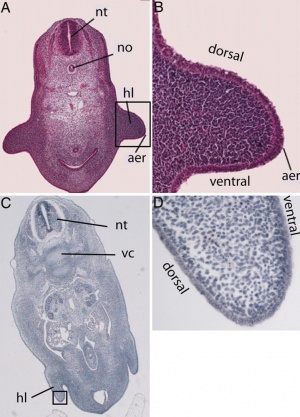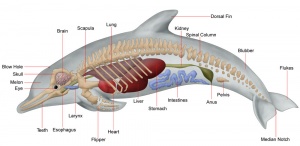Dolphin Development
Introduction
Delphinus
Some Recent Findings
|
Taxon
Suborder Odontoceti, toothed whales
- Family Delphinidae, oceanic dolphins
- Family Platanistidae
- Family Iniidae
- Family Lipotidae
- Family Pontoporiidae
Species
- Common bottlenose dolphin (Tursiops truncatus)
- Indo-Pacific bottlenose dolphin (Tursiops aduncus)
- Burrunan dolphin (Tursiops australis)
Development Overview
Limb Development

Researchers have identified that Sonic hedgehog (Shh), that in limb development is the signaling activity of the zone of polarizing activity (ZPA), is absent from the dolphin hind-limb bud. An absence of Hand2, an upstream regulator of Shh, leads to the failure to establish a ZPA.[3] The hind-limb bud initiates, but then bud arrests and degenerates around the fifth gestational week.
- Links: Limb Development | Sonic hedgehog
References
Reviews
<pubmed>10882306</pubmed>
Articles
<pubmed>20722252</pubmed> <pubmed>17957751</pubmed> <pubmed>17597550</pubmed> <pubmed>12845705</pubmed> <pubmed>4856964</pubmed>
Books
Search PubMed
Search PubMed: Dolphin development | cetacean development
External Links
External Links Notice - The dynamic nature of the internet may mean that some of these listed links may no longer function. If the link no longer works search the web with the link text or name. Links to any external commercial sites are provided for information purposes only and should never be considered an endorsement. UNSW Embryology is provided as an educational resource with no clinical information or commercial affiliation.
- Carnegie Stage 11 CRL: 4.7 mm Spotted Dolphin Embryo LACM 94674 | Section Index
- OhioLINK - Dolphin Embryo Digitized Slides
| Animal Development: axolotl | bat | cat | chicken | cow | dog | dolphin | echidna | fly | frog | goat | grasshopper | guinea pig | hamster | horse | kangaroo | koala | lizard | medaka | mouse | opossum | pig | platypus | rabbit | rat | salamander | sea squirt | sea urchin | sheep | worm | zebrafish | life cycles | development timetable | development models | K12 |
Glossary Links
- Glossary: A | B | C | D | E | F | G | H | I | J | K | L | M | N | O | P | Q | R | S | T | U | V | W | X | Y | Z | Numbers | Symbols | Term Link
Cite this page: Hill, M.A. (2024, April 28) Embryology Dolphin Development. Retrieved from https://embryology.med.unsw.edu.au/embryology/index.php/Dolphin_Development
- © Dr Mark Hill 2024, UNSW Embryology ISBN: 978 0 7334 2609 4 - UNSW CRICOS Provider Code No. 00098G

